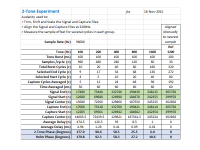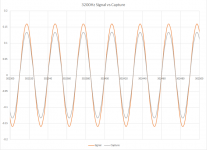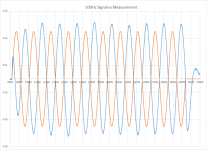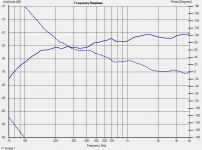I struggled to work out a 2-Tone method using my equipment, but was finally was able to conduct a reasonable test and analysis. Audacity was used to create a 6-tone signal and also to record it being played.
Below are the results of the '2-Tone' measurement Vs a Holm sweep measurement using the same setup and signal path.

Pretty good agreement considering the less than ideal process used for the 2-Tone test.
Below are the results of the '2-Tone' measurement Vs a Holm sweep measurement using the same setup and signal path.

Pretty good agreement considering the less than ideal process used for the 2-Tone test.
Correct. I did this a few pages ago and got the same results for phase in several softwares. That's because they are all doing it wrong, you know.

Pano,
Zero crossing would probably have work okay also, but there was a little very low freq swing ('DC offset') in some of the recorded signal that shifted the wave up/down by a small amount. That made me think that the zero crossing would have more variability in position than just using my best estimate of the peaks.
Then I found the low freq peaks (100, 200Hz) also contained a little noise that made identifying the peak accurately a little difficult so I decided to measure over several cycles of each burst and take the offset of the averages of the Signal Vs the Capture to help minimize the error.
The following are my notes from the experiment. Also attached is the full chart of the collected data and a couple other charts.
Process Summary
2-Tone test:
> Audacity used to create a .wav file containing tone bursts of 100ms each for 6 different frequencies. Each burst was separated by 500ms of silence.
> Mic was centered on speaker ~10cm from the baffle (SEAS 7" MW).
> XO and EQ was disabled so driver response in a sealed box was measured.
> The 2-Tone file was played by a DLNA server through my theater instrument rack and was recorded using Audacity on a Notebook PC used for all my audio measurements.
HolmImpulse Test:
> Exported the Holm signal to a .wav file so it could also be sent via DLNA so the measuring equipment would be identical for the 2 processes.
> Disabled the Holm soundcard and mic cal files.
> Took 6 measurements to assure that there was high repeatability. There was, so only the first measurement was used.
> Made a slight adjustment to the IR position to align the phase at 3200Hz to 0.0 degrees.
> Exported the SPL/Phase text file to read the phase at the 6 frequencies (placed that in last row in the table).
Analysis:
> Scaled the Signal SPL to approximate the Captured SPL level for each burst.
> Time aligned the 2-Tone signal and the 2-Tone Capture at 3200Hz in Audacity.
> Used Audacity to measure the sample offset of the Captured .wav Vs the Signal .wav for each of the 6 frequencies.
> Since the sample offset varied a little due to noise in the captured .wav an average was used across several cycles for each of the 6 captured bursts.
The repeatability and accuracy of the 2-Tone method I used here is not as good as using Holm or other audio analyzer, but agreement is good enough to suggest that the 2-Tone test can be used with reasonable accuracy. A better process would probably increase the accuracy, but the time requirement makes the method impractical.
Attachments:




Zero crossing would probably have work okay also, but there was a little very low freq swing ('DC offset') in some of the recorded signal that shifted the wave up/down by a small amount. That made me think that the zero crossing would have more variability in position than just using my best estimate of the peaks.
Then I found the low freq peaks (100, 200Hz) also contained a little noise that made identifying the peak accurately a little difficult so I decided to measure over several cycles of each burst and take the offset of the averages of the Signal Vs the Capture to help minimize the error.
The following are my notes from the experiment. Also attached is the full chart of the collected data and a couple other charts.
Process Summary
2-Tone test:
> Audacity used to create a .wav file containing tone bursts of 100ms each for 6 different frequencies. Each burst was separated by 500ms of silence.
> Mic was centered on speaker ~10cm from the baffle (SEAS 7" MW).
> XO and EQ was disabled so driver response in a sealed box was measured.
> The 2-Tone file was played by a DLNA server through my theater instrument rack and was recorded using Audacity on a Notebook PC used for all my audio measurements.
HolmImpulse Test:
> Exported the Holm signal to a .wav file so it could also be sent via DLNA so the measuring equipment would be identical for the 2 processes.
> Disabled the Holm soundcard and mic cal files.
> Took 6 measurements to assure that there was high repeatability. There was, so only the first measurement was used.
> Made a slight adjustment to the IR position to align the phase at 3200Hz to 0.0 degrees.
> Exported the SPL/Phase text file to read the phase at the 6 frequencies (placed that in last row in the table).
Analysis:
> Scaled the Signal SPL to approximate the Captured SPL level for each burst.
> Time aligned the 2-Tone signal and the 2-Tone Capture at 3200Hz in Audacity.
> Used Audacity to measure the sample offset of the Captured .wav Vs the Signal .wav for each of the 6 frequencies.
> Since the sample offset varied a little due to noise in the captured .wav an average was used across several cycles for each of the 6 captured bursts.
The repeatability and accuracy of the 2-Tone method I used here is not as good as using Holm or other audio analyzer, but agreement is good enough to suggest that the 2-Tone test can be used with reasonable accuracy. A better process would probably increase the accuracy, but the time requirement makes the method impractical.
Attachments:




Excellent! That is very close to what I wanted to do, a file that contains several blocks of frequencies to compare. Looks like it works very well. 
Good work on the averaging. When the phase shift is large, it's got to be easier to see. The small shifts must have been difficult to calculate. Nicely done, sir.
I think we can put this bugaboo to rest now.

Good work on the averaging. When the phase shift is large, it's got to be easier to see. The small shifts must have been difficult to calculate. Nicely done, sir.
I think we can put this bugaboo to rest now.
Yes, just summing them works fine.
The amplitude is increased, but that does not impact SPL shape for the purpose of creating EQ filters.
If you want to shift the overall level back down to the average level for any reason you can offset the level by:
dB offset = -20LOG(N)
Where N is number of measurements averaged.
The amplitude is increased, but that does not impact SPL shape for the purpose of creating EQ filters.
If you want to shift the overall level back down to the average level for any reason you can offset the level by:
dB offset = -20LOG(N)
Where N is number of measurements averaged.
Strange New Problems
Anyone else having new problems with HOLM? I'm running v1.4.2 (x64) on Windows 8.1 64 bit. It has suddenly gone wonky.
It will not import an impulse file, no matter what the format. I won't even import an impulse it just exported.
It will import in the 2 file tab, where you can bring in a Signal and Recording. I use this to cheat and bring in impulse files.
It will not do any Manipulations, such as C=A*B or C=A/B, unless I close it and reopen it fresh.
These are problems that I've never seen before as long as I've used HOLM. I did a re-install and it still has the same problems. Could this be a .net framework change or something?
Anyone else having new problems with HOLM? I'm running v1.4.2 (x64) on Windows 8.1 64 bit. It has suddenly gone wonky.
It will not import an impulse file, no matter what the format. I won't even import an impulse it just exported.
It will import in the 2 file tab, where you can bring in a Signal and Recording. I use this to cheat and bring in impulse files.
It will not do any Manipulations, such as C=A*B or C=A/B, unless I close it and reopen it fresh.
These are problems that I've never seen before as long as I've used HOLM. I did a re-install and it still has the same problems. Could this be a .net framework change or something?
hmm, whenever I have anything weird happen with holm I find the dir it stores the zip file in that has all of the measurements (there are a couple of other files too) and blow them all away. restart holm and it creates new ones (all settings go back to defaults) and it usually fixes it.. I think it is under something like c{\users\yourusername\appdata\roaming\holm impulse) do a search under c:\users\yourusername I've not got holmimpulse on this work laptop...
Tony.
Tony.
Anyone else having new problems with HOLM? I'm running v1.4.2 (x64) on Windows 8.1 64 bit. It has suddenly gone wonky.
It will not import an impulse file, no matter what the format. I won't even import an impulse it just exported.
It will import in the 2 file tab, where you can bring in a Signal and Recording. I use this to cheat and bring in impulse files.
It will not do any Manipulations, such as C=A*B or C=A/B, unless I close it and reopen it fresh.
These are problems that I've never seen before as long as I've used HOLM. I did a re-install and it still has the same problems. Could this be a .net framework change or something?
FYI:
I have had the same problems for a long time with both 32 and 64 bit versions of Holm. Now using windows 10, but it was the same when using windows 7. I didn't realize others can successfully import IRs. I hope someone has a solution.
Pano, Thanks for the workaround. I will give that try.
You're welcome. What I did was make an ideal impulse to be used as the Signal. Just one sample on. You can import a Recording (your impulse) to compare against the ideal impulse. Use the same sample rate, of course.
Tony, I dumped all the HOLM user data but to no avail. It still crashes when trying to import an impulse by itself.
It still crashes when trying to import an impulse by itself.
Tony, I dumped all the HOLM user data but to no avail.
Hmmm that doesn't sound promising. I guess it could be an incompatibility with whatever the latest .net patches are. I hope not, as it could be the death of it, since there has been no development for a long time.
Are all the other things still not working either?
Tony.
Are all the other things still not working either?
Tony.
I tried Pano's workaround for importing IR '.wav' files and it works great.
When IR math 'manipulation' stops working I have also just saved the file and reopened it. The 'manipulation' feature can then be used again.
I have not run into any issues with the rest of the program features.
When IR math 'manipulation' stops working I have also just saved the file and reopened it. The 'manipulation' feature can then be used again.
I have not run into any issues with the rest of the program features.
- Home
- Design & Build
- Software Tools
- HOLMImpulse: Measuring Frequency & Impulse Response